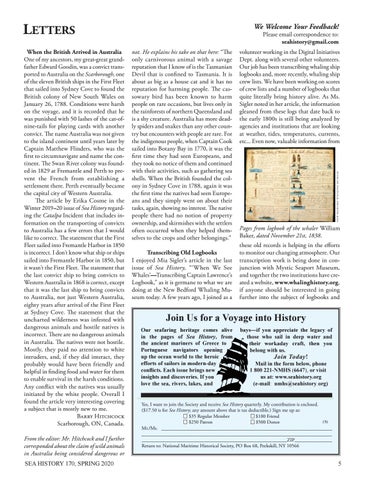Letters
From the editor: Mr. Hitchcock and I further corresponded about the claim of wild animals in Australia being considered dangerous or
Please email correspondence to: seahistory@gmail.com
not. He explains his take on that here: “The only carnivorous animal with a savage reputation that I know of is the Tasmanian Devil that is confined to Tasmania. It is about as big as a house cat and it has no reputation for harming people. The cassowary bird has been known to harm people on rare occasions, but lives only in the rainforests of northern Queensland and is a shy creature. Australia has more deadly spiders and snakes than any other country but encounters with people are rare. For the indigenous people, when Captain Cook sailed into Botany Bay in 1770, it was the first time they had seen Europeans, and they took no notice of them and continued with their activities, such as gathering sea shells. When the British founded the colony in Sydney Cove in 1788, again it was the first time the natives had seen Europeans and they simply went on about their tasks, again, showing no interest. The native people there had no notion of property ownership, and skirmishes with the settlers often occurred when they helped themselves to the crops and other belongings.” Transcribing Old Logbooks I enjoyed Mia Sigler’s article in the last issue of Sea History, “‘When We See Whales’—Transcribing Captain Lawrence’s Logbook,” as it is germane to what we are doing at the New Bedford Whaling Museum today. A few years ago, I joined as a
volunteer working in the Digital Initiatives Dept. along with several other volunteers. Our job has been transcribing whaling ship logbooks and, more recently, whaling ship crew lists. We have been working on scores of crew lists and a number of logbooks that quite literally bring history alive. As Ms. Sigler noted in her article, the information gleaned from these logs that date back to the early 1800s is still being analyzed by agencies and institutions that are looking at weather, tides, temperatures, currents, etc... Even now, valuable information from
new bedford whaling museum
When the British Arrived in Australia One of my ancestors, my great-great grandfather Edward Goodin, was a convict transported to Australia on the Scarborough, one of the eleven British ships in the First Fleet that sailed into Sydney Cove to found the British colony of New South Wales on January 26, 1788. Conditions were harsh on the voyage, and it is recorded that he was punished with 50 lashes of the cat-ofnine-tails for playing cards with another convict. The name Australia was not given to the island continent until years later by Captain Matthew Flinders, who was the first to circumnavigate and name the continent. The Swan River colony was founded in 1829 at Fremantle and Perth to prevent the French from establishing a settlement there. Perth eventually became the capital city of Western Australia. The article by Erika Cosme in the Winter 2019–20 issue of Sea History regarding the Catalpa Incident that includes information on the transporting of convicts to Australia has a few errors that I would like to correct. The statement that the First Fleet sailed into Fremantle Harbor in 1850 is incorrect. I don’t know what ship or ships sailed into Fremantle Harbor in 1850, but it wasn’t the First Fleet. The statement that the last convict ship to bring convicts to Western Australia in 1868 is correct, except that it was the last ship to bring convicts to Australia, not just Western Australia, eighty years after arrival of the First Fleet at Sydney Cove. The statement that the uncharted wilderness was infested with dangerous animals and hostile natives is incorrect. There are no dangerous animals in Australia. The natives were not hostile. Mostly, they paid no attention to white intruders, and, if they did interact, they probably would have been friendly and helpful in finding food and water for them to enable survival in the harsh conditions. Any conflict with the natives was usually initiated by the white people. Overall I found the article very interesting covering a subject that is mostly new to me. Barry Hitchcock Scarborough, ON, Canada.
We Welcome Your Feedback!
Pages from logbook of the whaler William Baker, dated November 21st, 1838. these old records is helping in the efforts to monitor our changing atmosphere. Our transcription work is being done in conjunction with Mystic Seaport Museum, and together the two institutions have created a website, www.whalinghistory.org, if anyone should be interested in going further into the subject of logbooks and
Join Us for a Voyage into History Our seafaring heritage comes alive in the pages of Sea History, from the ancient mariners of Greece to Portuguese navigators opening up the ocean world to the heroic efforts of sailors in modern-day conflicts. Each issue brings new insights and discoveries. If you love the sea, rivers, lakes, and
bays—if you appreciate the legacy of those who sail in deep water and their workaday craft, then you belong with us.
Join Today!
Mail in the form below, phone 1 800 221-NMHS (6647), or visit us at: www.seahistory.org (e-mail: nmhs@seahistory.org)
Yes, I want to join the Society and receive Sea History quarterly. My contribution is enclosed. ($17.50 is for Sea History; any amount above that is tax deductible.) Sign me up as: $35 Regular Member $100 Friend 170 $250 Patron $500 Donor Mr./Ms. _____________________________________________________________________ ____________________________________________________________________________ __________________________________________________________ZIP_______________ Return to: National Maritime Historical Society, PO Box 68, Peekskill, NY 10566
SEA HISTORY 170, SPRING 2020 5
